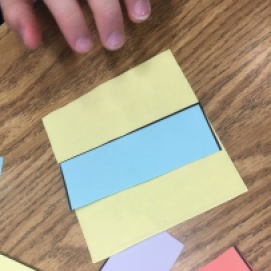I know you’ve probably seen this activity floating around the math blogosphere already, but I think it’s a really good one! I’m glad I gave it a try.
I used masking tape to make angles all over a table, then I had my grade 3 students (6 of them) use sharpie markers to find angles. After, we came up with a definition for “angle”. They decided it is where two straight lines meet each other. I didn’t tell them that – they figured it out. Next, I showed them how to use a protractor, and they measured angles. We then compared the angles and “discovered” 3 different kinds: right angles (somebody knew that), bigger than 90, and smaller than 90.



I gave them the vocabulary words – right, obtuse and acute. Then I gave them three pieces of paper with those words on top, and asked them to sort some pattern blocks.

Some of them had to go on two pieces of paper because they had two kinds of angles. Oh, and did you know there’s more than one way to make a triangle? This was surprising news! Again they used protractors, this time to justify their sorting.
Usually, I feel like, “Angles: check.” And I move on. But I feel like these activities really made sense to everyone, and they really learned something new (grade 3 is the first official place learning about angles takes place.) In fact, a week has past, and the tape is still in place. In their own “free” time, the students are still talking about their learning, and explaining to curious grade 2s what the tape is doing on the desk. Anybody who has taught for any length of time can testify to how hard it is for kids to leave tape on their desks alone!
I’ve spent a lot of time on Number Sense, but geometry is important too. I’ve got some interesting things to tell you about spatial sense as well, but I’ll save that for later.

















You must be logged in to post a comment.